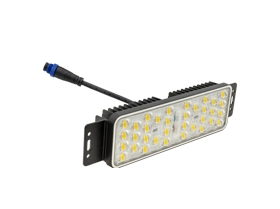Advantages and Application Prospects of Modular LED Street Lights
In recent years, as urban lighting demand continues to increase, the limitations of traditional LED street lights have gradually become apparent. Conventional LED street lights on the market often face quality issues such as poor heat dissipation and short lifespan of the driver power supply, which not only affect lighting performance but also increase maintenance and repair difficulties. The emergence of modular LED street lights is precisely to overcome these shortcomings.
What is a Modular LED Street Light?
Modular LED Street Lights are designed by integrating multiple LED light sources into a module that combines optics, heat dissipation, and dust and water resistance. Unlike traditional street lights where all LED light sources are installed within a single fixture, Modular LED Street Lights consists of multiple light source modules, enhancing the flexibility and maintainability of the fixture. The entire fixture is composed of three main parts: the fixture base, the light source module, and the driver. The base is responsible for fixing to the lamp pole and supporting the light source module; the light source module is the core of the fixture, integrating optics, heat dissipation, and protective functions, while the driver provides the necessary power for the fixture.
Maintenance Advantages of Modular LED Street Lights
Modular LED Street Lights are designed to make maintenance work more convenient and efficient. If the driver has a problem, users only need to replace the driver; if an LED light source module is damaged, only the corresponding module needs to be replaced. This maintenance method avoids replacing the entire fixture, saving resources and time. Additionally, the modules are relatively lightweight, making disassembly and replacement simple. If an LED lamp bead is damaged, maintenance personnel only need to disassemble the corresponding module without needing to disassemble and repair the entire fixture.
This rapid on-site maintenance capability not only improves work efficiency but also effectively extends the lifecycle of LED street lights. Most modules can be recycled after replacement, thus reducing waste. This aspect is especially important in today's society, which advocates sustainable development.
Improved Heat Dissipation and Luminous Efficiency of Modular LED Street Lights
In addition to maintenance convenience, modular LED street lights also have significant advantages in heat dissipation and luminous efficiency. The design of the modules takes into account the layout of ventilation holes, aiding air circulation, and thereby achieving effective heat dissipation. Additionally, the modular design allows each module to dissipate heat independently, eliminating the thermal resistance issues in traditional designs, and ensuring that the heat generated by each module can be dissipated timely and efficiently.
This optimized heat dissipation mechanism not only reduces the light decay phenomenon of LED street lights but also greatly improves luminous efficiency, ensuring the long-term stable operation of LED fixtures. Users can enjoy a more lasting and efficient lighting experience, reducing the inconvenience caused by fixture failures.
Future Development Trends of Modular LED Street Lights
With the emphasis on energy efficiency and sustainability in urban lighting, the application prospects of modular LED street lights are becoming increasingly broad. In the future, modular LED street lights are expected to be more widely adopted in various fields, from urban streets to highways, parks, and squares. The flexibility and efficiency of modular design will meet the lighting needs of different scenarios.
In conclusion, modular LED street lights not only overcome the maintenance and heat dissipation deficiencies of traditional LED street lights but also demonstrate unique advantages in energy efficiency and environmental protection. With continuous technological advancements, we have reason to believe that modular LED street lights will become an important trend in the future lighting market.
 English
English  العربية
العربية  中文
中文
 日本語
日本語
 Deutsch
Deutsch
 Türkçe
Türkçe



